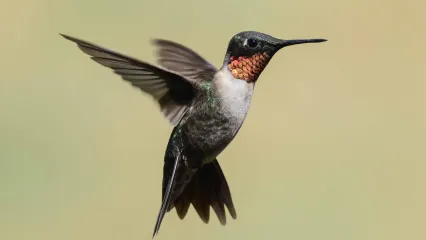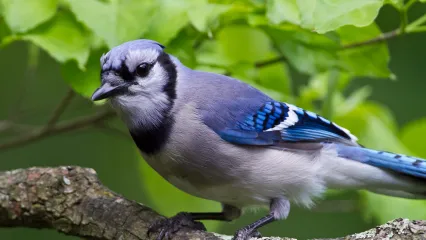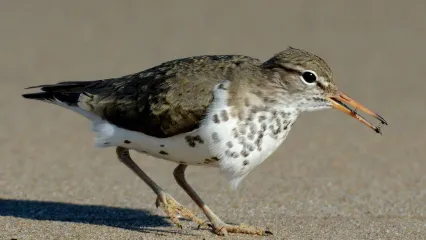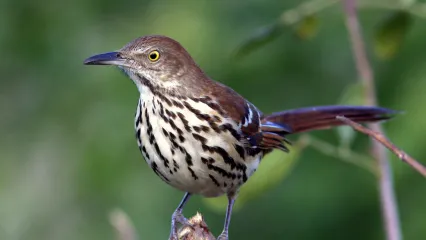
Description
Hummingbirds are Oklahoma’s smallest birds and are unique in many respects. They are the only birds that can hover, fly backward and upside down as easily as they fly forward. Of the four species of hummingbirds known to visit Oklahoma, the ruby-throated is the most widespread. Their feathers appear different shades of colors in varying degrees and angles of light. Back and crown feathers are basically green but may appear brown or gray. Adult male gorgets, or throats, may seem black until struck by sunlight, which turns them fiery red-gold. The female ruby-throat’s gorget is clear or faintly dotted, and her outer tail feathers are tipped with white. Immature ruby-throat’s look like females until young males begin to acquire a few red feathers in their gorgets. Other Oklahoma Hummingbirds: Black-chinned hummingbirds are most common after ruby-throats and occur in the far western part of the state, although they will frequent feeders elsewhere in the state during fall migration. The adult male’s gorget is black, bordered with an iridescent violet band. Rufous hummingbirds are an occasional fall migrant throughout the state. The adult male’s back and tail are cinnamon colored while the gorget is metallic copper. The female’s back is greenish with pale rufous sides. Broad-tailed hummingbirds are rare visitors to western Oklahoma. They are slightly larger than ruby-throats, and the adult male’s wings produce a distinctive, shrill whistling. Otherwise, they are similar, although their ranges generally do not overlap.
Size
Ruby-throats measure 3 inches to 3 ¾ from bill to tail and weight 2.5 to 3.5 grams (nine birds have a total of one ounce); the birds weigh more during migration.
Habitat
Ruby-throated hummingbirds are considered Neotropical migrants, which means they nest in North America and winter in Central and South America. The ruby-throats’ range extends from southern Canada throughout the eastern half of the United States to Central America. They are able to fly across the Gulf of Mexico by gaining significant weight during the end of summer.
Life Cycle
After arriving in Oklahoma, ruby-throats quickly mate and construct a nest, usually in mid-April. Their cup-shaped nests are not much larger than a walnut half and are made of spider webs, plant down and lichens. Nests are built 10-20 feet above ground, often in a fork of a downward-sloping branch. Females lay two white eggs about the size of navy beans, usually one day apart. The young hatch in 14-16 days and are ready to leave the nest about 21 days later. Sometimes two or even three broods are produced in a season. During spring migration, hummingbirds begin to arrive in Oklahoma in mid-March and early April, with males arriving first. In fall, males migrate first and may be gone by September. Females and young are mostly gone by mid-October, although some stragglers will remain.
How To Observe
A simple way to attract hummingbirds closer to your home is by setting out a sugar-water feeder. Use a formula of one part sugar to four parts boiled water to produce a solution that approximates that found in natural flower nectar. Never use honey or sugar substitutes. Place the feeders outside by early April and leave them up until at least November 1. This will provide for both early spring ruby-throats and late fall migrants, as well as the other three species of hummingbirds. Other birds such as orioles and chickadees also may be attracted to your hummingbird feeder. Feeders may be left out with fresh nectar as long as birds drink from them. The hummingbirds will migrate when they are ready, so leaving feeders up later will provide an additional energy source for any stragglers. Sometimes, hummingbirds will not use feeders during part of the summer. During this time, they are feeding off nectar from flowering plants and gleaning insects from flowers or the air for their young.
Place feeders in the shade. If more than one is used, place them far apart to avoid competition from the territorial hummingbirds. During cool weather, replace nectar and clean feeders at least once a week; during warm or hot weather, replace nectar and clean feeders every three or four days.
A better way to attract hummingbirds is by planting flowers. This provides both a natural nectar source for the birds and beautiful flowers for you to view. Flowering plants also provide protein in the form of aphids and other small insects and spiders. In general choose plants with tubular-shaped flowers that are reddish or pink in color. We recommend the following: coral honeysuckle, red buckeye, American columbine, Indian paintbrush, beard tongue, bee balm, and trumpet creeper.


